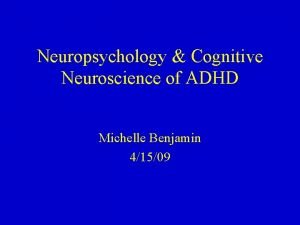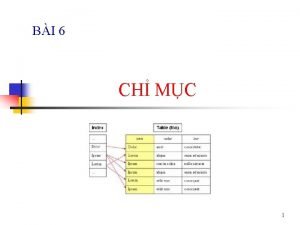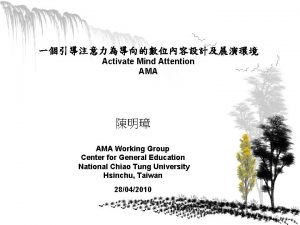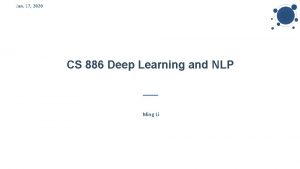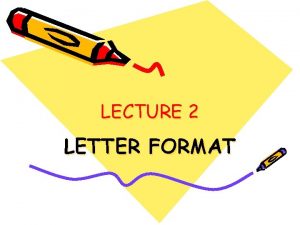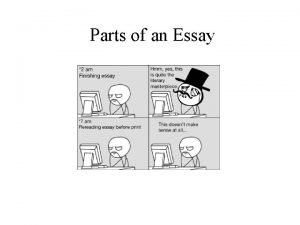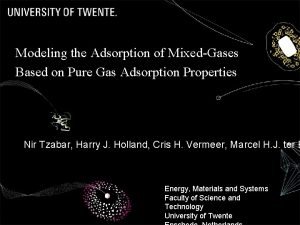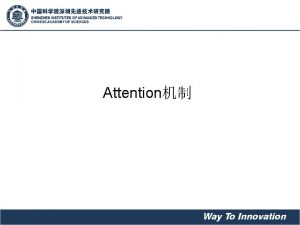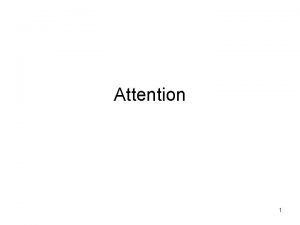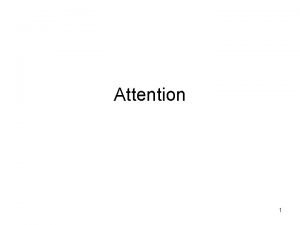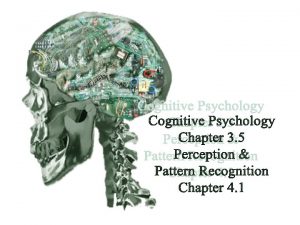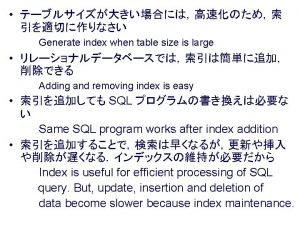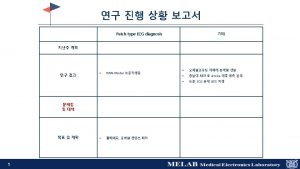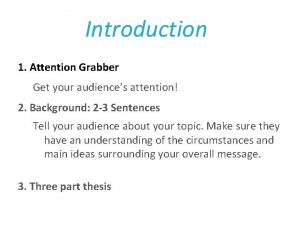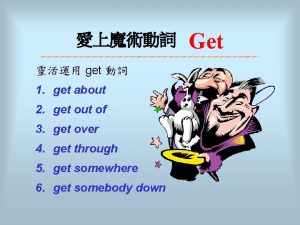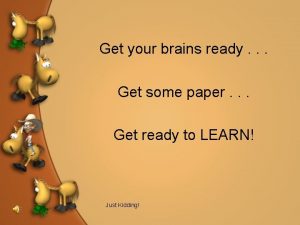How to get students attention Index 1 Attention































- Slides: 31

How to get students attention

Index • • • 1. Attention conditions 2. Attention types 3. Strategies to get children attention 4. Mantaining attention 5. Innapropiate teachers behaviour.

1. Attention Conditions External reasons: • Consequence of the atmosphere. • They help the pupil mantain his attention to those stimulus that are proposed to them, in other words, it depends on the enviroment.

a) Stimulus Strength: • A sharp, loud or distinctive sound is capable of catching our attention • For example, the teacher can play across a xylophone. • The same occurs with strong colours compared to soft colours.






b) Change • When we experience some kind of change, it modifies our field of perception; our attention is drawn to the stimulus that alters the stability of a situation.

c) Size • Big flashcards • This technique is also used in commercials or advertisements.


d) Repetition • A repetitive weak stimulus can have a big impact on the attention level • For example, the teacher might clap out a rhythm and have his students repeat the pattern.

e) Movement • The movement of an image (whether real or not) causes a reaction, which makes it a powerful attention-catcher. • Example: The curtains or blinds of the classroom should be closed in order to keep the students' attention in class.


f) Contrast • When a stimulus contrasts with the other stimuli around it, it stands out. • Two situations may occur: 1. The contrast results because the stimulus was absent until that moment. 2. The contrast is caused by the realization that something which was previously present has disappeared.

g) Structural organisation • Stimulus must be organised and ranked in order for the information to be received properly. • The teacher must present the material neatly.

Internal reasons: • The internal determinants are those which refer to the pupil. • They depend on the individual and they condition his/her learning even more, not only in the capacity and development of his/her attention, but in his/her overall performance.

a) Emotion Stimuli which cause strong emotions tend to attract our attention • Example: If a person is thirsty, it is obvious that he will be more attracted by stimulus linked to this necessity, say, a glass of water

b) Interests • This refers to those things that attract the students, depending on what they like

c) The Course of Thought • If a stimulus is presented to a person, and this person, at that moment, is thinking of something similar or related to it, the stimulus will get his attention immediately

2. Attention types • Focused attention: This is the ability to respond discretely to specific visual, auditory or tactile stimuli. • Sustained attention: This refers to the ability to maintain a consistent behavioral response during continuous and repetitive activity. • Selective attention: This level of attention refers to the capacity to maintain a behavioral or cognitive set in the face of distracting or competing stimuli. Therefore it incorporates the notion of "freedom from distractibility" • Alternating attention: It refers to the capacity for mental flexibility that allows individuals to shift their focus of attention and move between tasks having different cognitive requirements. • Divided attention: This is the highest level of attention and it refers to the ability to respond simultaneously to multiple tasks or multiple task demands.

3. - Strategies to catch students attention • Begin a familiar phrase and have your finish it Meanwhile. . . Back at the Ranch Chitty. . . Bang To Infinity. . . And Beyond Who you gonna call? . . . Ghostbusters Are you ready kids? . . . Aye Captain Who lives in a pineapple under the sea? . . . Sponge. Bob Squarepants

• Raise your hand quietly and wait until everyone else has his or her hand raised • Clap in a rhythm and have your students repeat the pattern. • Switch the light once. • Ring a bell. • Play across a xylophone. • Clap in a rhythm and have your students repeat the pattern.

• “Star Method” • Traditional Authority Use • Stopwatch

Magic word technique Their attention will magically appear when you use a � Magic Word�For example, if you were studying a unit on geometry, you might say: �“Class, since we are studying geometry, I am going to use the word � parallelogram� when I want your attention”.

4. Mainteining attention Is known that students use to lose attention if the class is boring, static and monotone. In fact, the teacher has to surprise more and more students changing the methods and strategies every day, if it´s possible, to motivate them.

What can the teacher do to maintein the students attention? • Create a good class atmosphere where kids feel comfortable and active in the group. • Dynamic lessons to make each class different. can

Create a good class atmosphere. • Respect and friendship - Recognize the authority. - Work in harmony among equals. • Good class organization - Well prepared lessons: time, activities, games, etc. - Classroom spaces. - Decoration.

Dynamic lessons • Different methods. Choose the better method for each topic. Try to be original and don´t repeat. • Variety of exercises. Work can be funny!

5. Inappropiate behaviour of the teacher Yelling: is not recommended because it increases the noise level in the room and projects non-verbally that you are not in control. Use always the same intonation: It creates a monotone lesson.
 Get into get out of
Get into get out of Figurative language in one thing by one direction
Figurative language in one thing by one direction Michelle benjamin phd
Michelle benjamin phd Rizal participated in the student demonstration in madrid.
Rizal participated in the student demonstration in madrid. What does teacher say to get the attention
What does teacher say to get the attention Get focused get results
Get focused get results Get up get moving quiz
Get up get moving quiz Germer
Germer Get up get moving quiz
Get up get moving quiz Pseudocode for repetition
Pseudocode for repetition Get up get moving quiz
Get up get moving quiz Index of consistency
Index of consistency Eryhtema nodosum
Eryhtema nodosum Clustered index và non clustered index
Clustered index và non clustered index Diff between step index and graded index fiber
Diff between step index and graded index fiber Pqli advantages and disadvantages
Pqli advantages and disadvantages Optical fibre
Optical fibre Simpson diversity index example
Simpson diversity index example Dense secondary index
Dense secondary index Activate mind and attention
Activate mind and attention Helicobacter pylori
Helicobacter pylori Merci de votre attention
Merci de votre attention Exploring self-attention for image recognition.
Exploring self-attention for image recognition. Algebraic representation
Algebraic representation Thank you for your attention
Thank you for your attention Wake up and pay attention
Wake up and pay attention Single headed attention rnn: stop thinking with your head
Single headed attention rnn: stop thinking with your head Attention line in address
Attention line in address Thank you for your attention do you have any questions
Thank you for your attention do you have any questions Renaissance 1350
Renaissance 1350 Grabber for an essay
Grabber for an essay Thank you for your attention
Thank you for your attention


